(数据结构)栈和队列
(数据结构)栈和队列
- 栈
- 概念与理解
- 实现
- 结构与方法
- 具体实现
- 算法题
- 有效的括号
- 队列
- 概念与理解
- 结构分析
- 实现
- 结构与方法
- 具体实现
- 算法题
- 用队列实现栈
- 用栈实现队列
- 循环队列
栈
概念与理解
栈是⼀种特殊的线性表,其只允许在固定的⼀端进行插入和删除元素操作。
进行数据插入和删除操作的⼀端称为栈顶,另⼀端称为栈底。
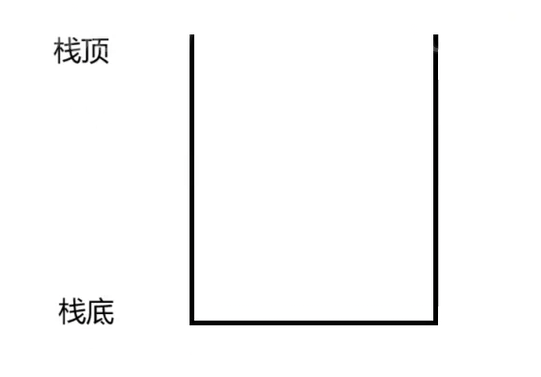
栈中的数据元素遵守后进先出LIFO(Last In First Out)的原则。
压栈:栈的插入操作叫做进栈/压栈/入栈
出栈:栈的删除操作叫做出栈。
出入数据都在栈顶。
栈的实现⼀般可以使用数组或者链表实现,相对而言数组的结构实现更优⼀些。因为数组在尾上插入数据的代价比较小。
作为特殊的线性表,栈的逻辑结构必然是线性的,物理结构上,若我们选择使用数组实现,则物理结构也是线性的。
实现
- 注意以下几个重点即可轻松实现:
- 数组的右边作为栈顶,元素从数组的左边开始入栈
- 栈包括一个数组、栈顶序号和容量大小
- 当top==capacity时,说明栈满,需要增容
结构与方法
typedef int STDataType;
typedef struct Stack
{STDataType* arr;int top;int capacity;
}ST;//初始化
void STinit(ST* ps);
//销毁
void STDestroy(ST* ps);
//判断栈是否为空
bool StackEmpty(ST* ps);
//入栈
void StackPush(ST* ps, STDataType x);
//出栈
void StackPop(ST* ps);
//取栈顶数据
STDataType StackTop(ST* ps);
//获取栈中有效数据个数
int STSize(ST* ps);
具体实现
//初始化
void STinit(ST* ps)
{ps->arr = NULL;ps->top = ps->capacity = 0;
}//入栈_只会在栈顶入栈
void StackPush(ST* ps, STDataType x)
{assert(ps != NULL);if (ps->top == ps->capacity) {//不要直接替换top和capacity!因为有可能realloc失败导致数据丢失!int newCapacity = ps->capacity == 0 ? 4 : 2 * ps->capacity;STDataType* tmp = (STDataType*)realloc(ps->arr, newCapacity*sizeof(STDataType));if (!tmp) {perror("realloc fail!");exit(1);}//realloc成功再替换ps->arr = tmp;ps->capacity = newCapacity;}ps->arr[ps->top++]=x;
}//判断栈是否为空
bool StackEmpty(ST* ps)
{assert(ps);return ps->top == 0;
}//出栈
void StackPop(ST* ps)
{assert(!StackEmpty(ps)); ps->top--;
}//取栈顶数据
STDataType StackTop(ST* ps)
{assert(!StackEmpty(ps));return ps->arr[ps->top - 1];
}//获取栈中有效数据个数
int STSize(ST* ps)
{assert(ps);return ps->top;
}
//销毁
void STDestroy(ST* ps)
{if (ps->arr)free(ps->arr);ps->arr = NULL;ps->top = ps->capacity = 0;
}
算法题
有效的括号
https://leetcode.cn/problems/valid-parentheses/description/
给定一个只包括 ‘(’,‘)’,‘{’,‘}’,‘[’,‘]’ 的字符串 s ,判断字符串是否有效。
有效字符串需满足:
左括号必须用相同类型的右括号闭合。
左括号必须以正确的顺序闭合。
每个右括号都有一个对应的相同类型的左括号。
-
为什么可以用栈解决?
对一个示例([ ])
我们以相同括号为整体一分为二
([ ])我们发现,左边的顺序是小括号、中括号,而右边的顺序就是中括号、小括号,我们对比一下顺序,发现和栈“先进后出”的特点是十分相似的。至此我们找到了“有效字符串”规则与栈的高度相似性。 -
转化思路:
对输入的字符串进行检索,遇到左括号时将其入栈,遇到右括号,就出栈将左括号和右括号进行配对,如果匹配就继续检索,如果不匹配直接return false。
最终检索结束,还要检查栈是否为空,保证每个括号都是一一成对的。
参考解法
typedef char STDataType;
typedef struct Stack
{STDataType* arr;int top;int capacity;
}ST;
//初始化
void STinit(ST* ps)
{ps->arr = NULL;ps->top = ps->capacity = 0;
}//入栈_只会在栈顶入栈
void StackPush(ST* ps, STDataType x)
{assert(ps != NULL);if (ps->top == ps->capacity) {//不要直接替换top和capacity!因为有可能realloc失败导致数据丢失!int newCapacity = ps->capacity == 0 ? 4 : 2 * ps->capacity;STDataType* tmp = (STDataType*)realloc(ps->arr, newCapacity*sizeof(STDataType));if (!tmp) {perror("realloc fail!");exit(1);}//realloc成功再替换ps->arr = tmp;ps->capacity = newCapacity;}ps->arr[ps->top++]=x;
}//判断栈是否为空
bool StackEmpty(ST* ps)
{assert(ps);return ps->top == 0;
}//出栈
void StackPop(ST* ps)
{assert(!StackEmpty(ps)); ps->top--;
}//取栈顶数据
STDataType StackTop(ST* ps)
{assert(!StackEmpty(ps));return ps->arr[ps->top - 1];
}//获取栈中有效数据个数
int STSize(ST* ps)
{assert(!StackEmpty(ps));return ps->top;
}
//销毁
void STDestroy(ST* ps)
{if (ps->arr)free(ps->arr);ps->arr = NULL;ps->top = ps->capacity = 0;
}bool isValid(char* s) {ST st;STinit(&st);//遍历给定的字符串schar* pi=s;while(*pi!='\0'){//左括号入栈if(*pi=='('||*pi=='['||*pi=='{')StackPush(&st,*pi);//否则遇到右括号出栈else{if(StackEmpty(&st)){STDestroy(&st);return false;}char top=StackTop(&st);if((top=='('&&*pi!=')')||(top=='['&&*pi!=']')||(top=='{'&&*pi!='}')){STDestroy(&st);return false;}StackPop(&st);}pi++;}//保证括号都配对if(StackEmpty(&st)){STDestroy(&st);return true;}//别忘了处理没通过的情况!elsereturn false;
}
队列
概念与理解
概念:只允许在⼀端进行插入数据操作,在另⼀端进行删除数据操作的特殊线性表,队列具有先进先出FIFO(First In First Out)
⼊队列:进行插入操作的⼀端称为队尾
出队列:进行删除操作的⼀端称为队头

结构分析
首先要判断队列的底层要用数组还是链表实现,使用数组的话,必然会在头删/头插的情况下出现时间复杂度为O(n)的操作,所以不考虑,使用单链表如下:
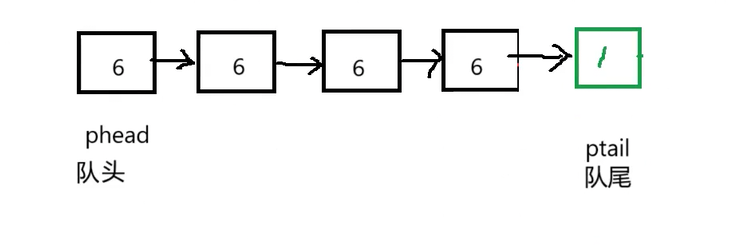
如果认为链表的头为队头,链表的尾为队尾,计算一下队尾入队的时间复杂度=尾插=O(n),而出队的时间复杂度=头删=O(1),如此一看链表似乎并没有在结构上优于数组,但是我们可以对此进行优化:
尾插时间复杂度为O(n)的原因是,对于常规的单链表结构,我们只存储了头结点,所以每次尾插都需要遍历到尾结点才能进行插入,但如果我们把尾结点也存储起来并进行同步的更新,尾插时间复杂度就可优化为O(1)
经过分析后获得入队和出队时间复杂度都为O(1)的链表结构如下:
typedef int QDataType;
typedef struct QueneNode {QDataType data;struct QueneNode* next;
}QueneNode;
//定义队列的结构
typedef struct Quene {struct QueneNode* phead;//队头struct QueneNode* ptail;//队尾
}Quene;
实现
结构与方法
#include <stdio.h>
#include <stdlib.h>
#include <assert.h>
#include <stdbool.h>typedef int QDataType;
typedef struct QueueNode {QDataType data;struct QueueNode* next;
}QueueNode;
typedef struct Queue {struct QueueNode* phead;//队头struct QueueNode* ptail;//队尾int size;//记录有效数据个数(降低求队列大小的算法的时间复杂度)//如果需要频繁调用队列大小的话,就在队列结构加入size,调用得少的话可以不加入
}Queue;//初始化
void QueueInit(Queue* pq);
//入队——队尾
void QueuePush(Queue* pq, QDataType x);
//判空操作——删除必备
bool QueueEmpty(Queue* pq);
//出队——队头
void QueuePop(Queue* pq);
//取队头数据
QDataType QueueFront(Queue* pq);
//取队尾数据
QDataType QueueBack(Queue* pq);
//销毁
void QueueDestroy(Queue* pq);
//队列有效数据个数
int QueueSize(Queue* pq);具体实现
//初始化
void QueueInit(Queue* pq)
{assert(pq);pq->phead = pq->ptail = NULL;
}
//入队——队尾
void QueuePush(Queue* pq, QDataType x)
{assert(pq);QueueNode* newnode = (QueueNode*)malloc(sizeof(QueueNode));if (newnode == NULL) {perror("malloc error");exit(1);}newnode->data = x;newnode->next = NULL;//队列为空,newnode既是队头也是队尾if (pq->phead = NULL) {pq->phead = pq->ptail = newnode;}//队列非空,直接插入到队尾else {pq->ptail->next = newnode;pq->ptail = pq->ptail->next;//记得更新ptail}pq->size++;
}//判空操作——删除必备
bool QueueEmpty(Queue* pq)
{assert(pq);return pq->phead==NULL;
}
//出队——队头
void QueuePop(Queue* pq)
{assert(!QueueEmpty(pq));//只有一个结点的情况if (pq->phead == pq->ptail) {free(pq->phead);pq->phead = pq->ptail=NULL;}else {QueueNode* next = pq->phead->next;free(pq->phead);pq->phead = next;} pq->size--;
}//取队头数据
QDataType QueueFront(Queue* pq)
{assert(!QueueEmpty(pq));return pq->phead->data;
}
//取队尾数据
QDataType QueueBack(Queue* pq)
{assert(!QueueEmpty(pq));return pq->ptail->data;
}//销毁
void QueueDestroy(Queue* pq)
{assert(pq);QueueNode* pcur = pq->phead;while (pcur) {QueueNode* next = pcur->next;free(pcur);pcur = next;}pq->phead = pq->ptail = NULL;
}//队列有效数据个数
int QueueSize(Queue* pq)
{return pq->size;
}
算法题
用队列实现栈
https://leetcode.cn/problems/implement-stack-using-queues/description/
题目:请你仅使用两个队列实现一个后入先出(LIFO)的栈,并支持普通栈的全部四种操作(push、top、pop 和 empty)。
实现 MyStack 类:
void push(int x) 将元素 x 压入栈顶。
int pop() 移除并返回栈顶元素。
int top() 返回栈顶元素。
boolean empty() 如果栈是空的,返回 true ;否则,返回 false 。
注意:
你只能使用队列的标准操作 —— 也就是 push to back、peek/pop from front、size 和 is empty 这些操作。
你所使用的语言也许不支持队列。 你可以使用 list (列表)或者 deque(双端队列)来模拟一个队列 , 只要是标准的队列操作即可。
思路:首先明确需要实现的功能有什么:
- void push(int x) 将元素 x 压入栈顶
- int pop() 移除并返回栈顶元素
- int top() 返回栈顶元素
- boolean empty() 如果栈是空的,返回 true ;否则,返回 false 。
其次明确我们的工具是两个队列,思考实现方式。
入栈:可以直接等效为入队
出栈:出栈与出队顺序就不一样了,我们画图模拟出栈顺序
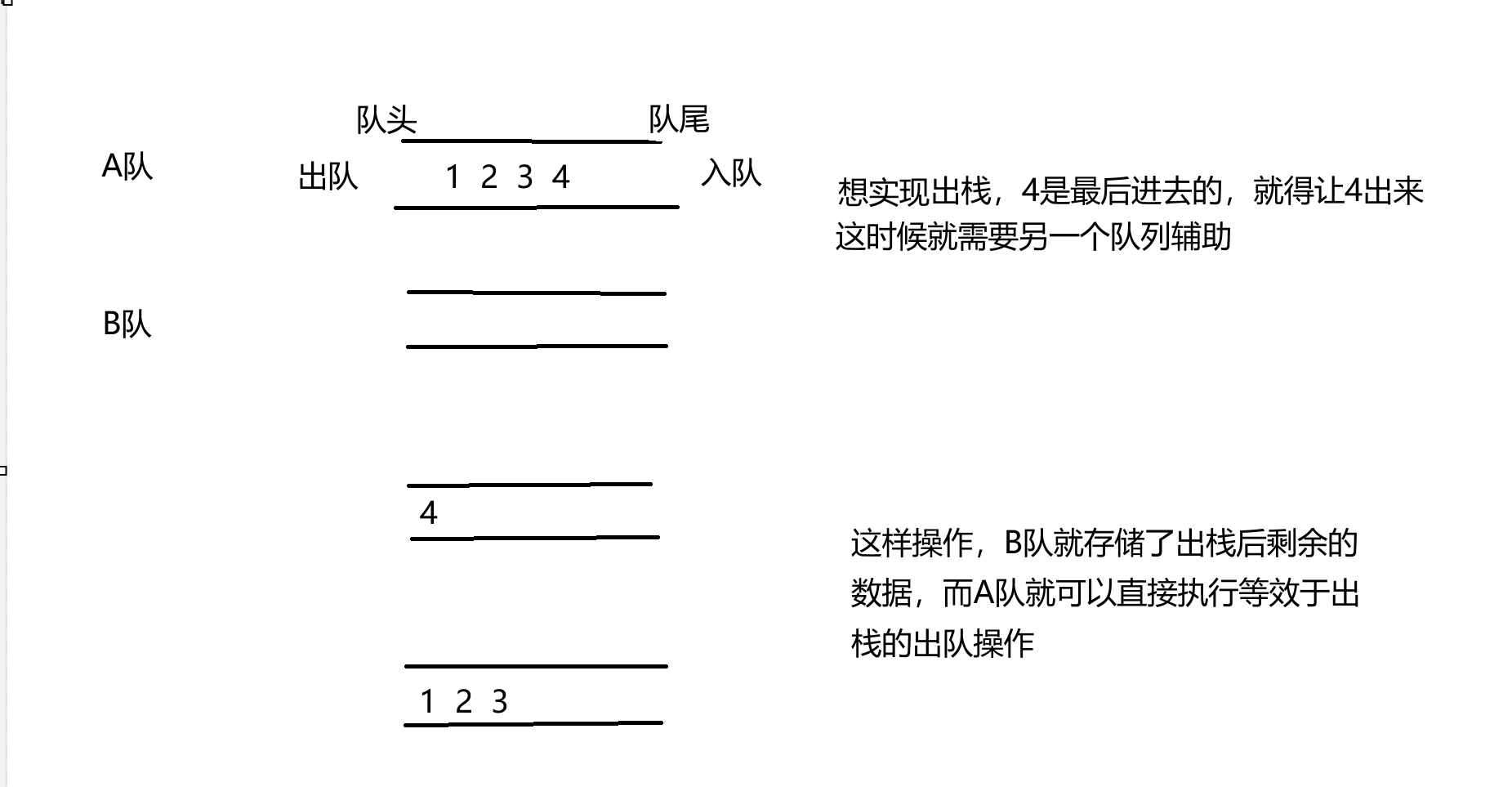
返回栈顶元素:使用取队尾操作
- 循环状态:出栈结束后,两个队列又回到一个存储元素,一个为空的状态,同样的初始状态便于出栈操作的进行
示例代码:
typedef int QDataType;
typedef struct QueueNode {QDataType data;struct QueueNode* next;
}QueueNode;
typedef struct Queue {struct QueueNode* phead;//队头struct QueueNode* ptail;//队尾int size;//记录有效数据个数(降低求队列大小的算法的时间复杂度)//如果需要频繁调用队列大小的话,就在队列结构加入size,调用得少的话可以不加入
}Queue;typedef struct {Queue q1;Queue q2;
} MyStack;//初始化
void QueueInit(Queue* pq)
{assert(pq);pq->phead = pq->ptail = NULL;pq->size = 0;
}
//入队——队尾
void QueuePush(Queue* pq, QDataType x)
{assert(pq);QueueNode* newnode = (QueueNode*)malloc(sizeof(QueueNode));if (newnode == NULL) {perror("malloc error");exit(1);}newnode->data = x;newnode->next = NULL;//队列为空,newnode既是队头也是队尾if (pq->phead == NULL) {pq->phead = pq->ptail = newnode;}//队列非空,直接插入到队尾else {pq->ptail->next = newnode;pq->ptail = pq->ptail->next;//记得更新ptail}pq->size++;
}//判空操作——删除必备
bool QueueEmpty(Queue* pq)
{assert(pq);return pq->phead==0;
}
//出队——队头
void QueuePop(Queue* pq)
{assert(!QueueEmpty(pq));//只有一个结点的情况if (pq->phead == pq->ptail) {free(pq->phead);pq->phead = pq->ptail=NULL;}else {QueueNode* next = pq->phead->next;free(pq->phead);pq->phead = next;} pq->size--;
}//取队头数据
QDataType QueueFront(Queue* pq)
{assert(!QueueEmpty(pq));return pq->phead->data;
}
//取队尾数据
QDataType QueueBack(Queue* pq)
{assert(!QueueEmpty(pq));return pq->ptail->data;
}//销毁
void QueueDestroy(Queue* pq)
{assert(pq);QueueNode* pcur = pq->phead;while (pcur) {QueueNode* next = pcur->next;free(pcur);pcur = next;}pq->phead = pq->ptail = NULL;
}//队列有效数据个数
int QueueSize(Queue* pq)
{return pq->size;
}MyStack* myStackCreate() {MyStack* ms=(MyStack*)malloc(sizeof(MyStack));QueueInit(&ms->q1);QueueInit(&ms->q2);return ms;
}void myStackPush(MyStack* obj, int x) {if(!QueueEmpty(&obj->q1)){QueuePush(&obj->q1,x);}else{QueuePush(&obj->q2,x);}
}int myStackPop(MyStack* obj) {Queue* emp=&obj->q1;Queue* noemp=&obj->q2;if(!QueueEmpty(&obj->q1)){emp=&obj->q2;noemp=&obj->q1;}while(noemp->size>1){QueuePush(emp,QueueFront(noemp));QueuePop(noemp);}int top=QueueFront(noemp);QueuePop(noemp);//最后一定要把这个队列清空,保证后面好判定谁是存储元素的队列return top;
}int myStackTop(MyStack* obj) {if(!QueueEmpty(&obj->q1)){return QueueBack(&obj->q1);}else{return QueueBack(&obj->q2);}
}bool myStackEmpty(MyStack* obj) {return QueueEmpty(&obj->q1)&&QueueEmpty(&obj->q2);
}void myStackFree(MyStack* obj) {QueueDestroy(&obj->q1);QueueDestroy(&obj->q2);
}用栈实现队列
https://leetcode.cn/problems/implement-queue-using-stacks/description/
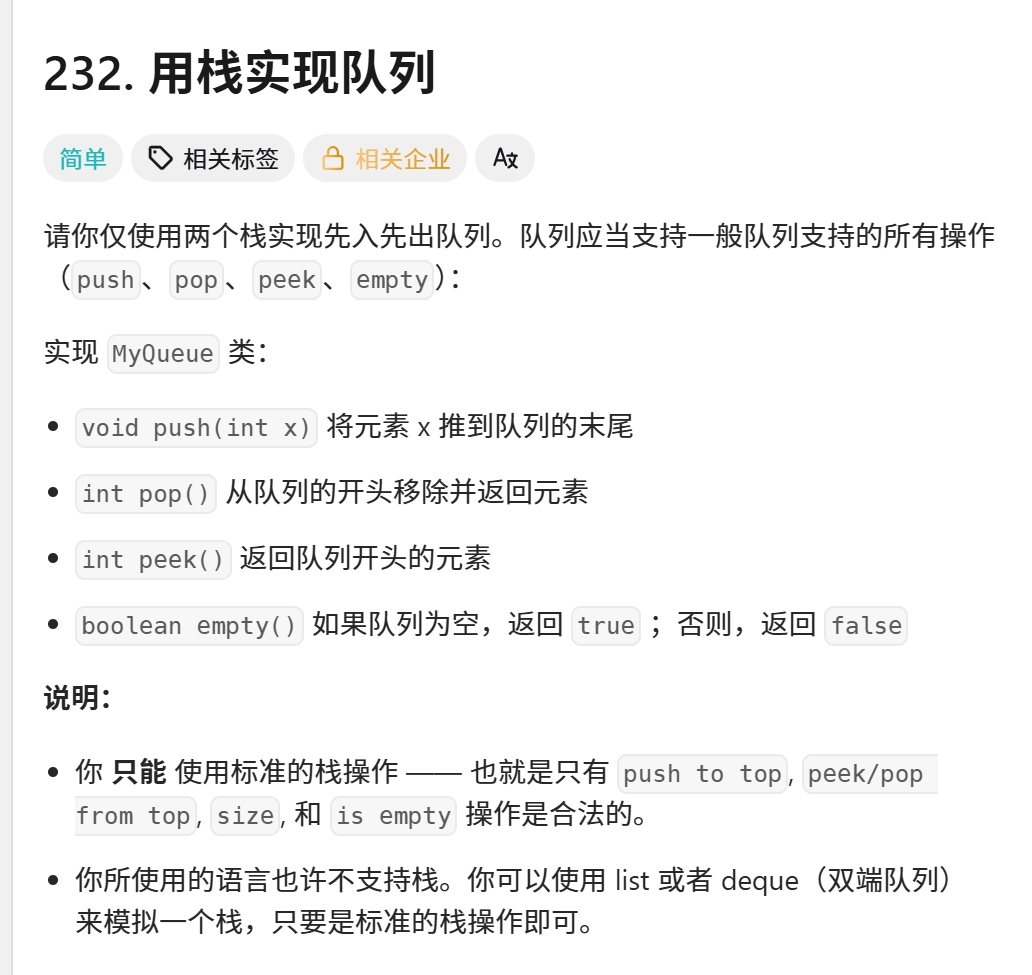
需要完成队列的入队、出队、取队头、判空的操作。
我们依旧要思考栈与队列不同的点和栈本身的特点。
队列的入队与出队顺序相同,而栈的入栈出栈顺序相反,我们可以利用这个特点,用两次出栈使最终出栈的元素顺序与最开始入栈顺序相同,即实现了入队操作。我们称左边第一次入栈进入的是pushST,第二次入栈进入的是popST,因为最终这个栈弹出的元素是出队的元素顺序。
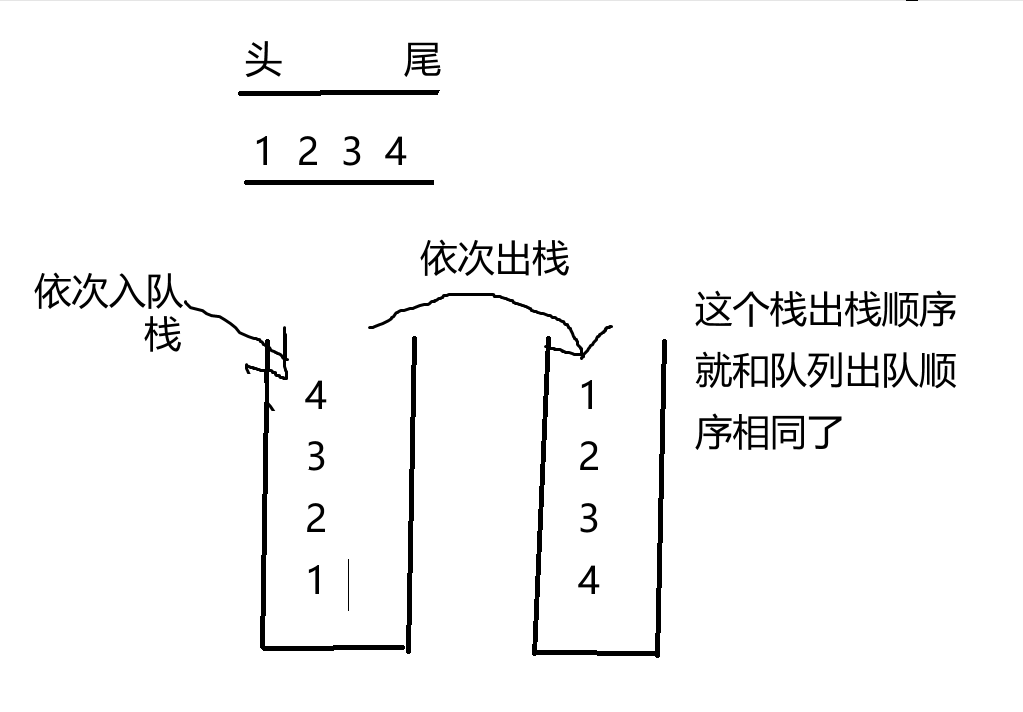
综上,入队=往pushST中插入数据
出队=popST不为空时直接出栈,为空时将pushST中的数据导入到popST后出栈
取队头=只取数据不pop的出队操作
typedef int STDataType;
typedef struct Stack
{STDataType* arr;int top;int capacity;
}ST;//初始化
void STinit(ST* ps);
//销毁
void STDestroy(ST* ps);
//判断栈是否为空
bool StackEmpty(ST* ps);
//入栈
void StackPush(ST* ps, STDataType x);
//出栈
void StackPop(ST* ps);
//取栈顶数据
STDataType StackTop(ST* ps);
//获取栈中有效数据个数
int STSize(ST* ps);typedef struct {ST pushST;ST popST;
} MyQueue;//初始化
void STinit(ST* ps)
{ps->arr = NULL;ps->top = ps->capacity = 0;
}//入栈_只会在栈顶入栈
void StackPush(ST* ps, STDataType x)
{assert(ps != NULL);if (ps->top == ps->capacity) {//不要直接替换top和capacity!因为有可能realloc失败导致数据丢失!int newCapacity = ps->capacity == 0 ? 4 : 2 * ps->capacity;STDataType* tmp = (STDataType*)realloc(ps->arr, newCapacity*sizeof(STDataType));if (!tmp) {perror("realloc fail!");exit(1);}//realloc成功再替换ps->arr = tmp;ps->capacity = newCapacity;}ps->arr[ps->top++]=x;
}//判断栈是否为空
bool StackEmpty(ST* ps)
{assert(ps);return ps->top == 0;
}//出栈
void StackPop(ST* ps)
{assert(!StackEmpty(ps)); ps->top--;
}//取栈顶数据
STDataType StackTop(ST* ps)
{assert(!StackEmpty(ps));return ps->arr[ps->top - 1];
}//获取栈中有效数据个数
int STSize(ST* ps)
{assert(ps);return ps->top;
}
//销毁
void STDestroy(ST* ps)
{if (ps->arr)free(ps->arr);ps->arr = NULL;ps->top = ps->capacity = 0;
}MyQueue* myQueueCreate() {MyQueue* mq=(MyQueue*)malloc(sizeof(MyQueue));STinit(&mq->pushST);STinit(&mq->popST);return mq;
}void myQueuePush(MyQueue* obj, int x) {StackPush(&obj->pushST,x);
}int myQueuePop(MyQueue* obj) {if(StackEmpty(&obj->popST)){while(STSize(&obj->pushST)){StackPush(&obj->popST,StackTop(&obj->pushST));StackPop(&obj->pushST);}}int top=StackTop(&obj->popST);StackPop(&obj->popST);return top;
}int myQueuePeek(MyQueue* obj) {if(StackEmpty(&obj->popST)){while(STSize(&obj->pushST)){StackPush(&obj->popST,StackTop(&obj->pushST));StackPop(&obj->pushST);}}return StackTop(&obj->popST);
}bool myQueueEmpty(MyQueue* obj) {return StackEmpty(&obj->pushST)&&StackEmpty(&obj->popST);
}void myQueueFree(MyQueue* obj) {STDestroy(&obj->pushST);STDestroy(&obj->popST);
}循环队列
https://leetcode.cn/problems/design-circular-queue/description/
循环队列首尾相连成环
- 循环队列特点:
- 队头删数据,队尾插入数据
- 给定固定的空间,使用过程中不可以扩容(这一点很适合用数组实现)
- 循环队列满了,不能继续插入数据(即插入数据失败)
- 实现
循环队列可以用数组实现,也可以用循环链表实现。
对比:哪个底层结构更好一点?数组的实现会更简便(不需要一个个开辟结点,存取数据方便)
如何判断队列为空为满?——增加一个空间
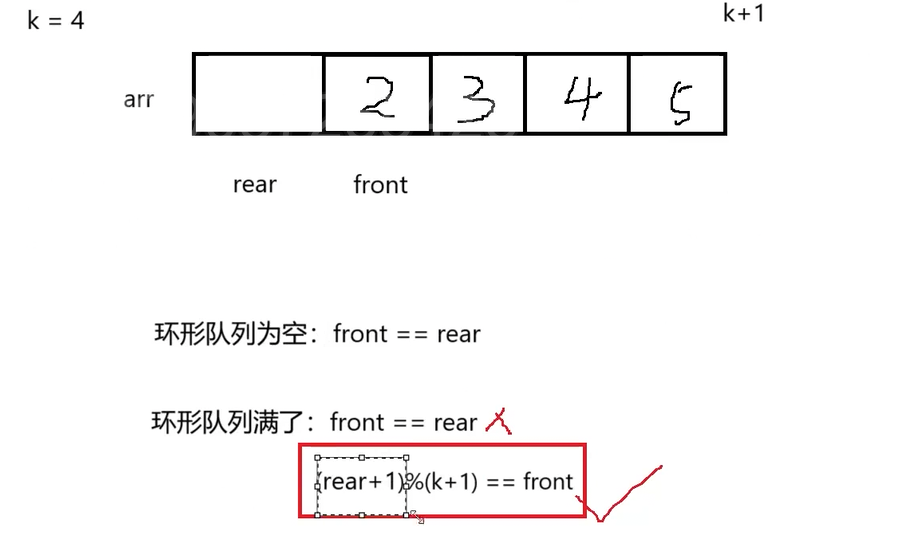
示例代码
typedef struct {int* arr;int front;int rear;int capacity;
} MyCircularQueue;bool myCircularQueueIsEmpty(MyCircularQueue* obj) {return obj->front==obj->rear;
}bool myCircularQueueIsFull(MyCircularQueue* obj) {return (obj->rear+1)%(obj->capacity+1)==obj->front;
}MyCircularQueue* myCircularQueueCreate(int k) {MyCircularQueue* pq=(MyCircularQueue*)malloc(sizeof(MyCircularQueue)*(k+1));pq->arr=(int*)malloc(sizeof(int)*(k+1));pq->front=pq->rear=0;pq->capacity=k;return pq;
}bool myCircularQueueEnQueue(MyCircularQueue* obj, int value) {//空间有限,插入前先判满!if(myCircularQueueIsFull(obj)){return false;}//没有满obj->arr[obj->rear++]=value;obj->rear%=obj->capacity+1;//处理超过capacity+1的情况return true;
}bool myCircularQueueDeQueue(MyCircularQueue* obj) {//删除前判空if(myCircularQueueIsEmpty(obj)){return false;}//删除=出队,是对队头进行操作!obj->front++;obj->front%=obj->capacity+1;return true;
}int myCircularQueueFront(MyCircularQueue* obj) {if(myCircularQueueIsEmpty(obj))return -1;return obj->arr[obj->front];
}int myCircularQueueRear(MyCircularQueue* obj) {if(myCircularQueueIsEmpty(obj))return -1;if(obj->rear==0)return obj->arr[obj->capacity];return obj->arr[obj->rear-1];
}void myCircularQueueFree(MyCircularQueue* obj) {if(obj->arr)free(obj->arr);free(obj);obj=NULL;
}